Sustainable Wedding Dresses: Something Old, Something new, Something borrowed, Something Green?
10/12/2020
Back to blogBeing such an important part of a Brides and couples special day really is an honour. Sometimes as designers and makers we get lost in the detail, in the design, in the fitting process of our brides, but we have never taken this for granted and have regular reminders of the special, once in […]

Being such an important part of a Brides and couples special day really is an honour.
Sometimes as designers and makers we get lost in the detail, in the design, in the fitting process of our brides, but we have never taken this for granted and have regular reminders of the special, once in a lifetime dress we make for our brides.
Our focus has always been, before we ever put pen to paper (or paint to walls!), when starting our business and brand was just a fraction of an idea, to ensure we deliver a service which is personal and individual. This remains, forever and always, for better or worse, with hundreds of recommendations and testimonials over the past 8 years to prove so. We are undoubtedly very proud of this..
Then there is the other side to what we do; the dress itself. The physical production of our dresses, designed, cut, made, fitted and finished. The product.

Does this dress look sustainable?
The majority of the time within our industry, the focus is on the happiness of couples, the beautiful setting and the togetherness of family and friends. Rightly so, this is the part all of us want to celebrate. However, as with all parts of our lives, the consideration of the ‘footprint’ we create and the lasting impact our actions and events have is growing and becoming an important aspect of wedding planning, wedding purchases and wedding styles.
There is a growing amount of press surrounding the subject of sustainable weddings and eco wedding dresses, as with all aspects of our daily lives. Something for us all to absorb, read and consider.
There is an increase in articles suggesting the best way to purchase your green sustainable eco wedding dress, which are at times simply (and sadly) quite misleading…
__________________
As we have seen with such environmental campaigners such as Venetia La Manna (great to follow to learn so much on sustainability), it is a difficult role to point the finger without being questioned and being able to answer these critics yourself (we do agree..). So, for that reason as a maker we have to firstly lay our cards on the table, be honest with our practises since our beginning and our actions moving forward. We have never branded ourselves as a sustainable or eco brand, never using this as a sales tactic, but we have always ensured two critical elements; Our production is in London, from design to finish and our main finished dress fabrics are silk and natural fibres;
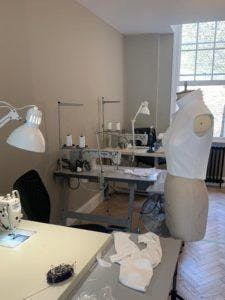
Our studio in Islington, London
All our dresses are made in London, in our own studio by our team employed by us and paid fair wages for their skills and roles.
Our main fabrics are natural silks and fibres, both outer layers and lining. Our silks are all produced by suppliers we have visited in person, have met the owners and workers and have long term ongoing relationships with. They are working in good conditions and paid responsibly and fairly for their work. We work with mills both in Asia and Europe.
Our outer layer silks for all our collection dresses are 100% natural silk. Our linings have been a silk and bamboo mix until recently, where we are planning to change to a 100% sustainable bamboo lining in 2021 for all our garments, working with a sole mill who are producing sustainable bamboo products, from fabrics to packaging.
Our laces are all French, from mills we have worked with for a long period of time. Lace does create real challenges with sustainable production. Many are made of or contain ‘Viscose’ derived from cellulose (wood-pulp), which does have potential for sustainable principles. The main issues with Viscose are based around the production of the fibres and the demand for such fibre. We have already reduced these fabrics, but will be looking to move away from laces which contain any man made fibres or where the viscose content is not certified, using alternative organic viscose or organic cotton embroideries for collections in the future.
We also use interlinings (layers between silk and lining) with some designs, of which are all natural cottons. We will be moving to a more sustainable cotton product in 2021, as cotton production has been highlighted due to its water consumption. Cotton equates to approximately 5% of the fabric we use, but remains an important aspect and an area we want to improve our sourcing.
For our toiles we have moved since 2019 to using our larger silk offcuts and cottons. Reducing off cut waste and reducing the use of any man made fibres for prototype toiles. We have not purchased any polyester fabrics for prototyping or toile since November 2019.
We are actively looking for ways to continue improving our sustainability. We approach it as a continuous work, never with a perfect answer but always room for change and improvement. With consideration for the options available to us, at our level of trading, with view across our industry and garment production as a whole, we feel we are doing many of the important things at this stage. Our approach to sustainability will be constantly reviewed and published to ensure our brides and our future brides understand our practises and the future changes we are working on to improve this further where possible.
What about silk production?
Silk production does not escape without its critics. These aspects include, water consumption, energy usage, workers conditions, chemical usage and silkworm treatment. We have worked to ensure our suppliers are meeting and addressing all of these ancient issues and meeting the requirements we expect.
Our silks are made from raw silk without any dyeing or softening processes. This removes large amounts of water consumption, energy usage, labour and chemical usage, seen with comparative cotton, linen and man made fabrics.
What about ‘peace’ silk? We have seen the use of ‘peace’ silks (Ahimsa silk) for wedding dresses. Peace silk is produced from a process that allows the silkworm to emerge from their cocoon and complete their natural life cycle. This in theory creates a better process for silk production, but in practise can be a very different outcome. Silk worms have been domesticated for thousands of years and cannot survive in most settings. Further, they are known to create issues damaging other insect habitats and environments. ‘PETA opposes the use of Peace Silk simply because there is no certification process to ensure the worms weren’t mistreated.’ (medium.com)
A good read in regards to silk production ‘Materials Index: Silk’ found on The Council of Fashion Designers of America (CFDA).
Can you make Vegan wedding dresses?
Yes. We have and we do already make vegan dresses for our brides. Our silks are exchangeable for other sustainable fabrics, such as organic cotton, organic bamboo silks, Tencel and others. We can source the fabric which is right for you and your wedding dress, whilst adhering to our sustainable approach and principles.
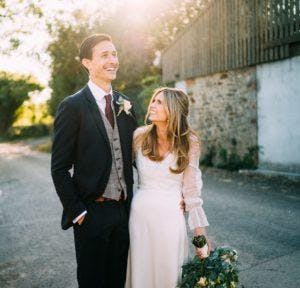
Does this dress ‘look’ sustainable?
_________________
So, what is a sustainable wedding dress?
Research is varied, unclear and often only answerable to one of many issues. Sustainability has to address all aspects or it is simply not sustainable. For instance one article we have recently read suggested, ‘We only use the finest laces, silks, embroideries and trims’, but followed by two clicks to an online store it is apparent that the majority of dresses out of the 50 listed were made from man made fabrics containing 90% polyester and 10% spandex or 60% nylon and 20% elastane. So regardless of their ‘ethical production’ they are using fabrics which will simply outlive any of us. This does not make for a sustainable model…
Some press articles list designers based on their production practises, reuse of offcuts or packaging. Made-to-order production is an important aspect and achievable at a lower level of production numbers within bridal. This becomes more difficult as a brand grows and with that production choices change, whether it remains possible to make per order or as a smaller ethical team is questionable and challenging. The reuse of offcuts is in my opinion a ‘nice’ way of approaching an unavoidable part of producing dresses, but not as practical as it is made to sound. Many offcuts are not reusable or capable of being repurposed. This is where using natural fibres is further highlighted as an important aspect when considering your sustainable wedding dress. Fabrics made from natural fibres at their final use will break down considerably faster and not release chemicals into the environment as with man made fabrics and fibres.
Packaging is an important aspect, but when this is used as a ‘sustainable’ answer by brands making from 100% polyester fabrics, this really does not have much overall bearing. This can only surely be considered asgreenwashing…
Briefing on Polyester by Common Objective and ‘Material index: Polyester’by CFDA are good places to start with understanding polyester production and its impact. ‘Polyester is a manufactured synthetic fiber. It is a kind of plastic and is usually derived from petroleum. Petroleum is a non-renewable resource and the petrochemicals industry has complicated social and political implications. Polyester generally has significant negative environmental impact during production, use, and disposal.’
“Polyester is much (much, much, much!) cheaper than natural fibers and it wears like iron – so you can keep your sofa looking good for 30 years. The real question is, will you actually keep that sofa for 30 years?” – O Ecotextiles
Or wear your wedding dress for 30 years?
Other recent press articles focus on repurposing an existing gown. Repurposing is a great way to approach a dress sustainably in 2020, but reality would suggest that the majority of brides-to-be will not have an existing gown appropriate for their wedding day and therefore a sustainable way to shop for your wedding outfit is a completely different concept and challenge. Many articles published recently include designers who are making the majority of their designs from polyester, simply removing any credibility or genuine guidance for brides.
Articles select some designers based on their approach to designing pieces which are to be repurposed after the wedding day. Articles focus on brands, stores and designers selling synthetic polyester dresses, ensuring that they will be for more than one day, as they will take anywhere up to 200 years to degrade once they have become disregarded and have the potential to become waste and landfill releasing harmful chemicals in the process. Including ‘shop now’ links direct to 100% polyester dresses, again removes credibility and true clarity for the reader. When approaching an article with direct focus on the sustainable aspect of any wedding dress, that has to be at the forefront, where is the dress made? What is the dress made from?
This in practise also has its limitations (even when making from natural fabrics), in the 9 years we have been designing and making wedding dresses, only a handful of brides have purposefully approached their wedding dress to be able to repurpose and wear again, this would equate to 1 or 2 percent from thousands of brides over this time. Many brides want to have their dress as a keep sake, some want to sell their dress on. This is further highlighted in our recent ‘Wedding Dress Sustainability’survey where quarter of the brides answered that they would wear again or alter to wear again. We have highlighted our post wedding services further recently as we support brides to clean and alter their dresses to give them the option to repurpose and wear their dress again. Maybe the undecided portion reflects the limitation on guidance and the options available, which are simply not being highlighted enough. We hope to improve this communication and make this more of a consideration when brides are searching for their dress.
DO YOU PLAN TO AFTER YOUR WEDDING (WITH YOUR DRESS);
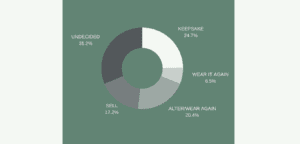
Taken from our Sustainability survey – November 2020
___________________
The answer?
To some of these questions and issues, has instantly been by many designers to use ‘Recycled’ polyester or rPET, with fabric names like eco-satin, collections called Earth or Eco and dresses with names like ‘Stay Green’ appearing. Sounds like we have it solved with the perfect answer?
‘How Sustainable is Recycled polyester?‘ written by Marjorie van Elven on Fashion United, highlights some reasons why we should be sceptical towards this magical answer. ‘Although recycling plastic sounds like an indisputable good idea, rPET’s celebration is far from being a unanimity in the sustainable fashion community.’
The processes and degeneration of the polymer through these processes create issues within themselves and limitations to the finished product and its future recycling potential. It appears too soon in the technology of recycling polyester fabric to champion this as the answer, alongside the unavoidable fact that virgin polyester has to be produced to then be recycled in the first instance…
Other articles considering rPET:
OECOTEXTILES Blog: Issues with using recycled polyester
IISD Institution: Sustainable Cotton or recycled polyester? The conscious shopper’s dilemma
CONSCIOUS Magazine/Blog: The recycled polyester trend and raised questions about its sustainability
COMMON OBJECTIVE Network: Is recycled polyester green or greenwashing?
____________________
What about the cost?
We have always ensured, despite continued rising silk prices, that our collections are competitively priced within a marketplace dominated by polyester manufactured dresses. Our prices reflect the quality and cost of our fabrics, the in house production in Central London and the personal service we give all our brides, regardless of the type of purchase they make.
Our services give a range of options for brides to ensure there is an option for all budgets. From our full bespoke design service to our altered samples we want to ensure all brides-to-be have access to our quality dresses and service.
Silk fabric can be anywhere between 5x – 10x higher in price to purchase than polyester equivalents at trade. This is a huge factor in influencing the choice of fabric from design stage through to final retail price. It is evident that some designers use silk sparingly throughout collections to allow them to use ‘silk’ as a buzzword. These are often lower cost lightweight or sheer fabrics such as organza and chiffon. Dresses can be found which are silk top fabrics but polyester lined to reduce the cost.
Design and Production; is a broad spectrum, with many ethical issues at the lower end of this spectrum. Garment production as a whole has been widely publicised for negative stories, including production in the UK. A recent article in The Guardian raising awareness of issues within garment production in the UK is worth a read. Sadly sometimes the basics, working conditions and fair pay, are not present and the retail price is more important than the person who makes the garment. It is important to know where and whom your dress is made by.
QUESTION 2: WOULD YOU INCREASE YOUR BUDGET IF YOU KNEW YOUR DRESS WAS MADE SUSTAINABLY?

QUESTION 3: IS THE FABRIC QUALITY OF YOUR DRESS AS IMPORTANT AS THE DESIGN?
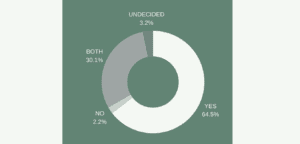
Taken from our Sustainability survey – November 2020
___________________
Final note; Our answer? The future?
Sustainability is at the forefront of everything we now do. It simply has to be, whether in our daily lives or planning your wedding. We want to continue working on our practises and closing the loops where we can. We want this to be communicated, to educate brides whilst doing their dress searching and appointments and for it to be a key factor in their dress choice.
Our answer remains the same as it has since our beginning; Made-to-order, ethically produced in the UK by our in house team from natural fabrics. However, we want to continue to improve all aspects further where we can…
Made-to-order; We aim to make every dress to order, whether it is a standard size with alterations, made to measure or a bespoke design. We produce minimal collection samples, which are used within our showroom for brides to try on. These samples are sold whilst in good to perfect condition to ensure they are used beyond sample purposes.
Ethical production; Fully designed and made in London, by our in house team, nothing outsourced down to the buttons on our dresses. Full control of our production, fair pay in line with UK and London salaries, in good working conditions.
Natural fabrics; Committed to natural fabrics, purchasing no man made fabrics, moving to more sustainable options in 2021 and beyond for linings, trims and interlinings.

How about this one? Is it sustainable?
___________________
We are also launching the AH tree project…From December 2020, we will be planting a tree for every new AH bride who purchases their special dress with us. We are also committed to planting a tree for every bride who has had their 2020 wedding postponed to the future. We will be talking more about this project and publishing the numbers over the course of next year, including how this offsets our footprint, this is all in line with the project announced by the Woodland Trust – ‘The Big Climate Fightback’ (which we feel passionately about supporting). We look forward to sharing this and more about our sustainability commitments moving forward.
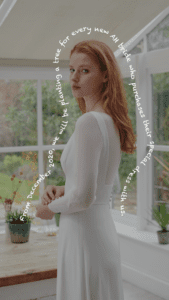
Written by Daniel Ayres, AH Production Manager. Contributed by the AH Team. x
References and things to read:
Issues with using recycled polyester – OECOTEXTILES Blog
Sustainable Cotton or recycled polyester? The conscious shopper’s dilemma – IISD Institution
The recycled polyester trend and raised questions about its sustainability – CONSCIOUS Magazine/Blog
Is recycled polyester green or greenwashing? – Common Objective
Briefing on Polyester – Common Objective
‘How Sustainable is Recycled polyester?’ – Fashion United
To Polyester or not polyester – OECOTEXTILES Blog
greenwashing – sustainable jungle
‘Viscose’ – goodonyou.org
‘Materials Index: Silk’ by CFDA
‘Material index: Polyester’ by CFDA
10 best sustainable wedding dresses for ethical brides
Shopping for a sustainable wedding outfit is easier than you think, heres how
Our favourite sustainable wedding dress brands
How to find a wedding dress that’s for more than just one day